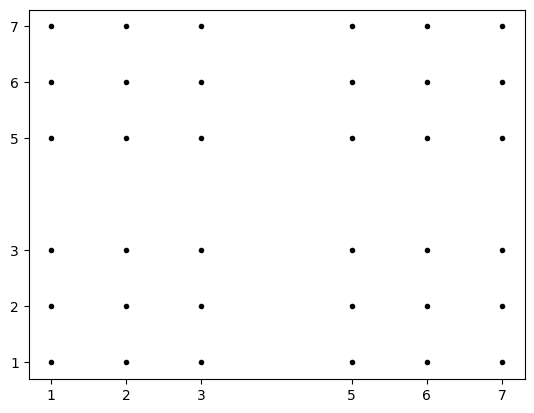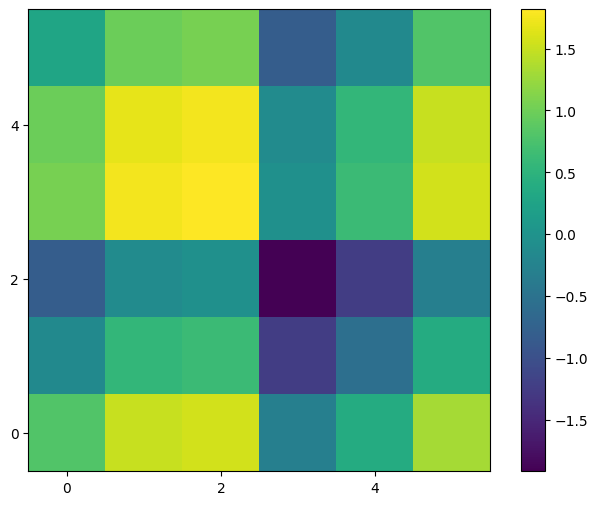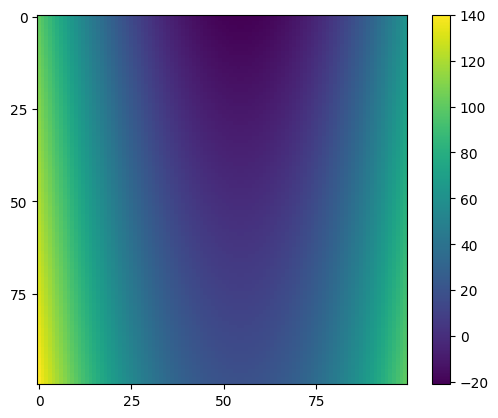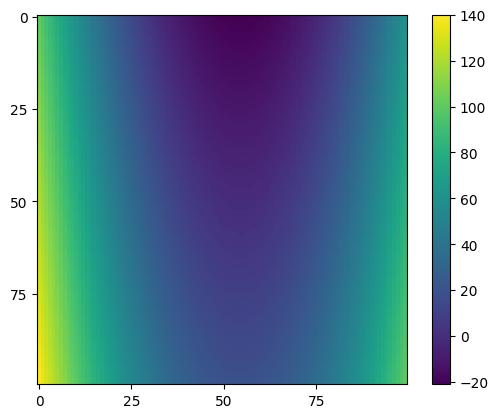Grids in numpy
import numpy as np
import matplotlib.pyplot as plt%matplotlib inlinea = np.array([3, 1, 2, 5, 6, 7])
b = np.array(a[::-1])
x, y = np.meshgrid(a, b)x, y(array([[3, 1, 2, 5, 6, 7],
[3, 1, 2, 5, 6, 7],
[3, 1, 2, 5, 6, 7],
[3, 1, 2, 5, 6, 7],
[3, 1, 2, 5, 6, 7],
[3, 1, 2, 5, 6, 7]]),
array([[7, 7, 7, 7, 7, 7],
[6, 6, 6, 6, 6, 6],
[5, 5, 5, 5, 5, 5],
[2, 2, 2, 2, 2, 2],
[1, 1, 1, 1, 1, 1],
[3, 3, 3, 3, 3, 3]]))
plt.plot(x, y, marker='.', color='k', linestyle='none')
plt.xticks(a)
plt.yticks(a)
plt.show()
Remarks
- Using meshgrid, we can create coordinate metrices
x,y. - Meshgrid allows to make all possible combinations for given arrays elements.
Plotting two dimension functions
Sine function
def sin(x, y):
return np.sin(x) + np.sin(y)z = sin(x, y)
zarray([[ 0.79810661, 1.49845758, 1.56628403, -0.30193768, 0.3775711 ,
1.3139732 ],
[-0.13829549, 0.56205549, 0.62988193, -1.23833977, -0.558831 ,
0.3775711 ],
[-0.81780427, -0.11745329, -0.04962685, -1.91784855, -1.23833977,
-0.30193768],
[ 1.05041743, 1.75076841, 1.81859485, -0.04962685, 0.62988193,
1.56628403],
[ 0.98259099, 1.68294197, 1.75076841, -0.11745329, 0.56205549,
1.49845758],
[ 0.28224002, 0.98259099, 1.05041743, -0.81780427, -0.13829549,
0.79810661]])
plt.figure(figsize=(8, 6))
plt.imshow(z, origin='lower')
plt.colorbar()
plt.locator_params(axis='y', nbins=4)
plt.locator_params(axis='x', nbins=4)
plt.show()
seq = np.linspace(-10, 10, 100)
x, y = np.meshgrid(seq, seq)z = sin(x, y)plt.figure(figsize=(8, 6))
plt.imshow(z)
plt.colorbar()
plt.locator_params(axis='x', nbins=4)
plt.locator_params(axis='y', nbins=4)
plt.show()
Another function
z = x ** 2 + (y - x) * 2plt.imshow(z)
plt.colorbar()
plt.locator_params('x', nbins=4)
plt.locator_params('y', nbins=4)
plt.show()
Plotting 3D functions
from mpl_toolkits.mplot3d import Axes3Dfig = plt.figure(figsize=(8, 4))
ax = fig.add_subplot(projection="3d")
ax.plot_surface(x, y, z)
plt.show()
Approaching same problem without meshgrid
x2 = np.linspace(-10, 10, 100)[np.newaxis]
y2 = np.linspace(-10, 10, 100)[:, np.newaxis]z2 = x ** 2 + (y - x) * 2
plt.imshow(z)
plt.colorbar()
plt.locator_params('x', nbins=4)
plt.locator_params('y', nbins=4)
plt.show()
Remarks
- This approach is more memory efficient than using meshgrid because it has very less elements that meshgrid.
What about performance?
seq = np.linspace(-10, 10, 10000)
x, y = np.meshgrid(seq, seq)
%time x ** 2 + (y - x) * 2CPU times: user 664 ms, sys: 421 ms, total: 1.09 s
Wall time: 1.09 s
array([[100. , 99.9559996, 99.9120072, ..., 59.9280088,
59.9640004, 60. ],
[100.0040004, 99.96 , 99.9160076, ..., 59.9320092,
59.9680008, 60.0040004],
[100.0080008, 99.9640004, 99.920008 , ..., 59.9360096,
59.9720012, 60.0080008],
...,
[139.9919992, 139.9479988, 139.9040064, ..., 99.920008 ,
99.9559996, 99.9919992],
[139.9959996, 139.9519992, 139.9080068, ..., 99.9240084,
99.96 , 99.9959996],
[140. , 139.9559996, 139.9120072, ..., 99.9280088,
99.9640004, 100. ]])
x2 = np.array([seq])
y2 = x2.T
%time x2 ** 2 + (y2 - x2) * 2CPU times: user 442 ms, sys: 382 ms, total: 824 ms
Wall time: 847 ms
array([[100. , 99.9559996, 99.9120072, ..., 59.9280088,
59.9640004, 60. ],
[100.0040004, 99.96 , 99.9160076, ..., 59.9320092,
59.9680008, 60.0040004],
[100.0080008, 99.9640004, 99.920008 , ..., 59.9360096,
59.9720012, 60.0080008],
...,
[139.9919992, 139.9479988, 139.9040064, ..., 99.920008 ,
99.9559996, 99.9919992],
[139.9959996, 139.9519992, 139.9080068, ..., 99.9240084,
99.96 , 99.9959996],
[140. , 139.9559996, 139.9120072, ..., 99.9280088,
99.9640004, 100. ]])
Remarks
Performance is better than the meshgrid